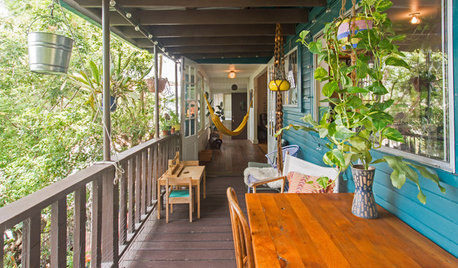What would worms best like to live in?
gonebananas_gw
12 years ago
Related Stories

GARDENING GUIDESHouzz TV: Make a Worm Bin for Rich Soil and Happy Plants
A worm-powered compost bin that can fit under a sink turns food scraps into a powerful amendment for your garden. Here’s how to make one
Full Story
ARCHITECTUREThink Like an Architect: How to Pass a Design Review
Up the chances a review board will approve your design with these time-tested strategies from an architect
Full Story
SHOP HOUZZShop Houzz: Live Like a Libra
Designer furniture, soft earth tones and a modern kitchen. Who couldn’t get used to living like this?
Full Story
ECLECTIC HOMESMy Houzz: A Treehouse-Like Dwelling in Los Angeles
Fragrant breezes, chirping birds and glorious sunsets provide a beautiful live-work setting for this design couple and their kids
Full Story
REMODELING GUIDESHouzz Survey Results: Remodeling Likely to Trump Selling in 2014
Most homeowners say they’re staying put for now, and investing in features to help them live better and love their homes more
Full Story
BEFORE AND AFTERSA Made-Over Living Room Preens Like a Peacock
Spirited accessories and his-and-her furnishings feather a family’s nest splendidly
Full Story
LIFEHow to Outsmart Backyard Critters
Learn to think like a raccoon, skunk or squirrel to keep your home safe and your garden intact
Full Story
PRODUCT PICKSGuest Picks: In Like a Lion, Out Like a Lamb
Take a cue from the classic adage about March with home accessories that call these animals to mind
Full Story
BATHROOM DESIGNNew This Week: 3 Bathrooms That Feel More Like Living Spaces
Graphic wallpaper, ornate chandeliers and furniture-like pieces help these bathrooms seem less like a sterile space and a lot more like home
Full Story
HOUZZ TV FAVORITESHouzz TV: See What It’s Like to Live in a Glass House
Tour a couple’s midcentury modern Illinois home, where floor-to-ceiling views of nature are all around
Full StorySponsored
Your Custom Bath Designers & Remodelers in Columbus I 10X Best Houzz
More Discussions






sbryce_gw
sbryce_gw
Related Professionals
Clark Landscape Architects & Landscape Designers · Forest Park Landscape Architects & Landscape Designers · Sand Springs Landscape Architects & Landscape Designers · Maple Heights Landscape Architects & Landscape Designers · Canyon Lake Landscape Contractors · Chesapeake Ranch Estates Landscape Contractors · El Reno Landscape Contractors · Maywood Landscape Contractors · Natick Landscape Contractors · Palos Hills Landscape Contractors · Clearfield Landscape Contractors · Franklin General Contractors · Hanford General Contractors · New Bern General Contractors · San Marcos General Contractorsgonebananas_gwOriginal Author
sbryce_gw
rookie09
gonebananas_gwOriginal Author
mr_yan
morgan_3
gonebananas_gwOriginal Author
sbryce_gw